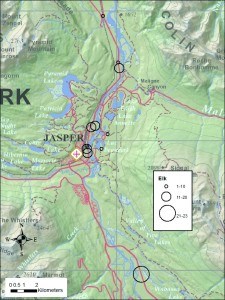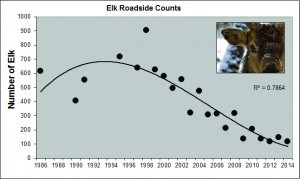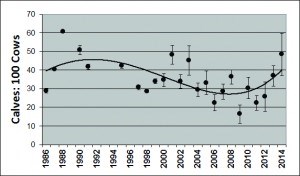Parks Canada wildlife specialists completed the 28th annual roadside elk count in Jasper National Park this December.
The park’s elk count started in 1986 to monitor local population trends. Resource conservation staff monitor all the roads in the park’s main valleys, as well as Buffalo Prairie, over a specific period of time each year and count as many elk as possible. The elk count collects data for a trend estimate, to monitor how the number of elk may be changing.
This year, park staff counted 115 elk along the main roadsides.
 This map shows where the elk were located during this year’s count from Dec. 2 to Dec. 4, 2014. Compared with historical data, it appears that the distribution of elk has changed over the years, with many moving closer to town. This is likely due to the fact that our valley bottom developments provide a refuge from predators and abundant food.
This map shows where the elk were located during this year’s count from Dec. 2 to Dec. 4, 2014. Compared with historical data, it appears that the distribution of elk has changed over the years, with many moving closer to town. This is likely due to the fact that our valley bottom developments provide a refuge from predators and abundant food.
Most elk in this year’s count were concentrated near the Jasper townsite, along Highway 16 approximately six kilometres east of the town, and along the Icefields Parkway, approximately 10 kilometres south of town.
NOTE: The count does not include the Rocky River group in the east end of the park, since they are dispersed away from the highway.
 Jasper National Park’s elk have been declining in numbers since 1994, but data collected through the roadside counts show they have been considered stable over the last four years.
Jasper National Park’s elk have been declining in numbers since 1994, but data collected through the roadside counts show they have been considered stable over the last four years.
The present number of elk is well within the target density for the Three Valley Confluence. This decreased population could also mean good news for threatened Woodland caribou, since fewer elk encourage lower predator numbers on the landscape and therefore fewer wolves finding their way into caribou habitat.
The total population estimate of elk in Jasper National Park is approximately 500 animals.
 The other important piece of information wildlife specialists obtain from the count is the number of calves per 100 cows.
The other important piece of information wildlife specialists obtain from the count is the number of calves per 100 cows.
This measurement gives specialists a good understanding of how many elk are entering the population each year. Data shows that the number of calves has been increasing over the last four years.
Information from the roadside elk count is useful to many park programs.
The data aids everything from elk management for visitor safety, to aspen monitoring, to caribou conservation (elk are a food source for wolves and therefore the number of elk can have an effect on caribou populations) and restoring healthy ecosystems.
Parks Canada
Special to the Fitzhugh
